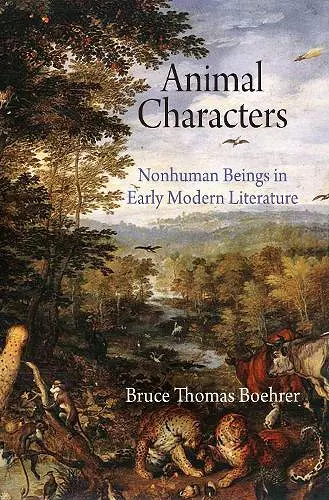Animal Characters
Nonhuman Beings in Early Modern Literature
Format:Hardback
Publisher:University of Pennsylvania Press
Published:27th Jul '10
Currently unavailable, and unfortunately no date known when it will be back

Animal Characters follows five species through the literature of early modern Europe. The horse, the parrot, the cat, the turkey, and the sheep all undergo a dramatic change in character as European writers begin to develop a new interest in—and understanding of—human character in its relation to literature.
Animal Characters follows five species through the literature of early modern Europe. The horse, the parrot, the cat, the turkey, and the sheep all undergo a dramatic change in character as European writers begin to develop a new interest in-and understanding of-human character in its relation to literature.
During the Renaissance, horses—long considered the privileged, even sentient companions of knights-errant—gradually lost their special place on the field of battle and, with it, their distinctive status in the world of chivalric heroism. Parrots, once the miraculous, articulate companions of popes and emperors, declined into figures of mindless mimicry. Cats, which were tortured by Catholics in the Middle Ages, were tortured in the Reformation as part of the Protestant attack on Catholicism. And sheep, the model for Agnus Dei imagery, underwent transformations at once legal, material, and spiritual as a result of their changing role in Europe's growing manufacturing and trade economies. While in the Middle Ages these nonhumans were endowed with privileged social associations, personal agency, even the ability to reason and speak, in the early modern period they lost these qualities at the very same time that a new emphasis on, and understanding of, human character was developing in European literature.
In Animal Characters Bruce Thomas Boehrer follows five species—the horse, the parrot, the cat, the turkey, and the sheep—through their appearances in an eclectic mix of texts, from romances and poetry to cookbooks and natural histories. He shows how dramatic changes in animal character types between 1400 and 1700 relate to the emerging economy and culture of the European Renaissance. In early modern European culture, animals not only served humans as sources of labor, companionship, clothing, and food; these nonhuman creatures helped to form an understanding of personhood. Incorporating readings of Shakespeare's plays, Milton's Paradise Lost, Margaret Cavendish's Blazing World, and other works, Boehrer's series of animal character studies illuminates a fascinating period of change in interspecies relationships.
"Always succinct, surprising and often amusing, this book is a joy to read. The detail is where it shines. . . . Animal Characters records, represents, and renews early modern animals with style, wit, and erudition." * Shakespeare Studies *
"An interesting take on the problematic question of literary character, as well as a significant contribution to scholarship on anthropocentrism and the cultural history of personhood. The enthusiasm and scope of the writing make it an engaging read, and the depth and breadth of the source material is quite fascinating." * The Medieval Review *
ISBN: 9780812242492
Dimensions: unknown
Weight: unknown
256 pages